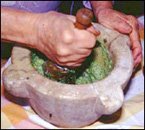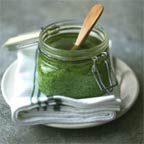Pesto Genovese
written by David Anderson limited rights reserved ViewItaly.blogspot.com
 Comfort foods are man’s capability to bend the environment to meet his needs. Developed from basic ingredients that surround him, he combines, cooks, and marinates until those basic ingredients are flavorful, nutritious and satisfying. This does not happen over night but centuries of ingenuity create truly delightful recipes. Pesto is one of these comfort foods.
Comfort foods are man’s capability to bend the environment to meet his needs. Developed from basic ingredients that surround him, he combines, cooks, and marinates until those basic ingredients are flavorful, nutritious and satisfying. This does not happen over night but centuries of ingenuity create truly delightful recipes. Pesto is one of these comfort foods. Pesto finds its first written confirmation at the time of the rise of the Roman Empire, several thousand years ago. The beautiful but treacherous, and extremely important militarily, Liguria is the birthplace of Pesto. Simple in nature, flavorful yet complimentary, Pesto uses one of the most antique herbs as its primary ingredient, Basil. One prepared Pesto can be stored for several months without refrigeration. The oil eliminates oxidation and bacterial growth. The sweet garlic balances the bright flavors of the Basil and the pine nuts hold the sauce together and give it a bit of structure.
Pesto finds its first written confirmation at the time of the rise of the Roman Empire, several thousand years ago. The beautiful but treacherous, and extremely important militarily, Liguria is the birthplace of Pesto. Simple in nature, flavorful yet complimentary, Pesto uses one of the most antique herbs as its primary ingredient, Basil. One prepared Pesto can be stored for several months without refrigeration. The oil eliminates oxidation and bacterial growth. The sweet garlic balances the bright flavors of the Basil and the pine nuts hold the sauce together and give it a bit of structure. There are many recipes for pesto. In the US, some chefs will add parsley. Do not do this. It is stupid. The only reason they add the parsley is to get the dark green color when their basil is limp and weak in flavor. If pesto is what you want then make pesto, buy quality ingredients, or better yet grow your own. Take the time to prepare the pesto according to the original method. If you use a food processor it will go faster but you will lose both color and flavor. Impossible, you say, actually the nature of the Basil leaf tells the story.
There are many recipes for pesto. In the US, some chefs will add parsley. Do not do this. It is stupid. The only reason they add the parsley is to get the dark green color when their basil is limp and weak in flavor. If pesto is what you want then make pesto, buy quality ingredients, or better yet grow your own. Take the time to prepare the pesto according to the original method. If you use a food processor it will go faster but you will lose both color and flavor. Impossible, you say, actually the nature of the Basil leaf tells the story.The flavor of Basil is held in the veins. When the veins are cut, the fluid inside is trapped in the veins and does not propagate. Additionally the flavor of basil changes when the oils are heated. The heat rising from the motor of the food processor is sufficient to initiate this change.
 Pesto is a great sauce to have on hand all year around. It is a great sauce for pasta and can be used to stuff or spread on bread, and it is a marvelous compliment when rolled in pork or beef roasts.
Pesto is a great sauce to have on hand all year around. It is a great sauce for pasta and can be used to stuff or spread on bread, and it is a marvelous compliment when rolled in pork or beef roasts.This is the best recipe I have found, actually Raffaella found this one. It is the one that we have used for many years. It is offered by the Consorzio del Pesto Genovese.
A Marble mortar is necessary for the preparation of this sauce.
Ingredients:
60 leaves of Genovese Basil
1 cup olive oil
3 tablespoons of grated Parmesan cheese
3 tablespoons of grated Pecorino cheese
2 cloves of garlic (peeled and cleaned)
1 tablespoon of pine nuts (pinoli)
¼ teaspoon coarse sea salt
Preparation:
Wash the Basil leaves and dry in a kitchen towel. Be sure the leaves are completely dry before beginning.
 Place the garlic and 10 leaves of Basil in the mortar. With a slow, circular motion, crush the garlic and basil into a paste. Do not put too much pressure on the basil. Continue adding the basil, 10 leaves at a time until you have a bright green liquid. This will take some time. Do not rush.
Place the garlic and 10 leaves of Basil in the mortar. With a slow, circular motion, crush the garlic and basil into a paste. Do not put too much pressure on the basil. Continue adding the basil, 10 leaves at a time until you have a bright green liquid. This will take some time. Do not rush.Add the pine nuts and completely reduce them into the liquid. The pine nuts will balance the garlic and give a delicate hint of nuts.
Stir in the Parmesan and Pecorino cheese and the salt. Finally, slowly drip in the olive oil, stirring continuously. Your pesto is ready!
Tags: Pesto Genovese Italian Sauces Basil Italian Recipes Food and Wine Travel Italy
Labels: Genova, Gourmet Foods, Italian Recipes, Liguria, Pasta, Sauces



6 Comments:
Allora! Now you're talking... I always make my own pesto, can't stand the ready made variety. As for adding parsley? Sacrilege!!!
5:14 PM
Aussie Yam - When prepared fresh it will last for several months. Once you have started using it you will want to consume within a couple of weeks if kept in the fridge. Another thing we will do is prepare the pesto without the cheeses, then freeze it in small containers for up to six months. Once thawed we add the cheeses.
ChickyBabe - Industrial pesto uses sunflower seed oil instead of olive oil. For some that is ok but for me the olive oil is an important ingredient.
5:40 PM
Travel, basil is my favourite herb and I absolutely adore pesto - I often bring some back from Liguria home made. I've heard this before that you shouldn't chop basil as it bruises the leaf and stops the flavour coming through but i've seen chefs do it - no idea have they? We often have this pasta recipe which I recommend you should try. Fry a red onion with some olive oil, fry some pancetta, finally add the pesto and some toasted pine nuts - it's quick and delicious.
3:24 PM
ACT - It takes longer to prepare the pesto with the mortar. Chopping is faster and an industrial chef is only thinking about how to move things faster. This is one of the reasons that here in the US they also add parsley. It helps them cover up the fact that they ruined the pesto.
6:06 PM
I had Barilla's pesto with great gusto for the first time when in Italy. I was looking for the recipe since I don't find a commercial product of pest in my country.
I came across quite a few web sites of pesto and this is the best for me so far because of the concise and interesting description and small but pretty pictures in a neat layout.
The inconvenience which I face is that I cannot find a marble mortar/pestle and pine nuts.
The former can be substituted by ceramic ones and I wish it won't affect the flavor and taste so much. But there is no substitute for the latter here.
Pine trees are commonly seen even here but we unfortunately have no traditional food culture of eating their seeds and I never see them in the market actually. It's a shame.
Anyway, I enjoy your website and pesto alla genovese senza pinoli.
12:50 AM
Anon Thank you for reading.
3:14 AM
Post a Comment
<< Home